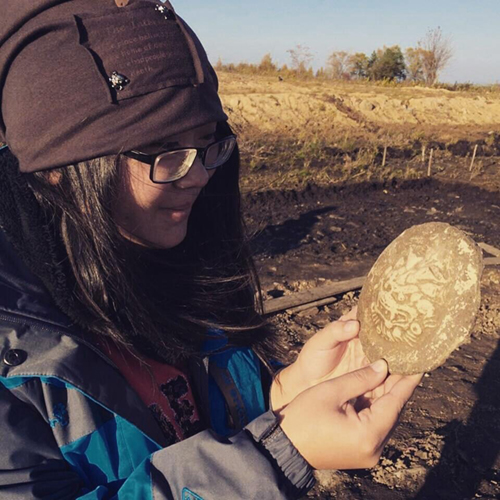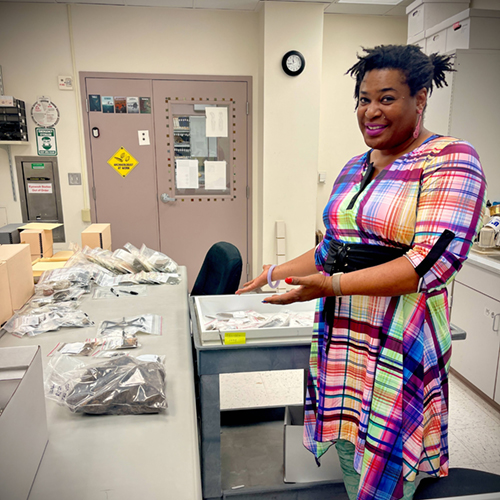Subarctic Stories, Global Insights

Wei Liu presents her poster "Microstructure of Alaska Interior Pottery Sherds" at the 2025 Alaska Anthropological Association annual conference.
The University of Alaska Fairbanks Department of Anthropology proudly celebrated a strong showing at the 2025 Alaska Anthropological Association (AAA) Annual Meeting, held in Anchorage this spring. With a robust mix of poster presentations and paper talks, UAF PhD students and faculty demonstrated the academic rigor, interdisciplinary expertise, and community-oriented spirit that define the department.
This year’s meeting of the AAA brought together scholars, practitioners, and students from across the state and beyond to explore human history, culture, and archaeology in Alaska and the Circumpolar North. The association’s mission centers on advancing the knowledge of Alaska's past and present through research and collaboration—and the annual meeting serves as a cornerstone for professional development and scholarly exchange.
The event offered an impressive platform for UAF’s graduate students to share their original research, much of which was developed in close collaboration with department faculty. Three standout poster presentations on Friday exemplified the cutting-edge scholarship coming out of Anthropology's PhD program:

Stable Isotopic Evidence for Pottery Uses in Interior Alaska
Wyatt Rowe presented “Stable Isotopic Evidence for Pottery Uses in Interior Alaska”, exploring how isotopic analysis can reveal ancient subsistence and pottery practices among Athabaskan groups. Liu’s work ties advanced scientific techniques to cultural heritage, enriching our understanding of diet and food processing in precontact Alaska.

Microstructure of Alaska Interior Pottery Sherds
Wei Liu showcased “Microstructure of Alaska Interior Pottery Sherds,” highlighting the ceramic technology and production techniques of Athabaskan potters. Liu’s research contributes to a growing body of knowledge about Indigenous technological innovation in the Subarctic.

African American Soldiers World War II Winter Encampment Site 35
MoHagani Magnetek, a writer, educator, and public scholar, presented “African American Soldiers World War II Winter Encampment Site 35,” based on research from the Alaska Highway Historical Archaeology Field School. Her work highlights the role of Black soldiers in WWII Alaska and reflects her focus on Black feminist archaeology and cultural memory.
The presentations reflected not just individual academic excellence but also meaningful collaboration with faculty mentors. Assistant Professor Tammy Buonasera and Professor Joshua Reuther were co-authors on the research presented by Wei Liu and Wyatt Rowe, while Assistant Professor Justin Cramb collaborated with MoHagani Magnetek on her field school poster. This synergy between students and faculty speaks to the department’s emphasis on hands-on research and building professional experience through shared inquiry.
Beyond the posters, UAF students also delivered insightful paper presentations during sessions spanning Thursday and Friday. These 20-minute talks provided the opportunity to delve deeper into research questions, theoretical frameworks, and fieldwork experiences:

Wyatt Rowe presents his poster "Stable Isotopic Evidence for Pottery Uses in Interior Alaska" at the 2025 Alaska Anthropological Association annual conference.
- Rowe and Liu teamed up again for their co-authored presentation, “Preliminary Study on Use and Manufacture of Late Precontact Athabaskan Pottery,” contributing new data and perspectives on Subarctic material culture.
- MoHagani Magnetek offered an evocative and critical presentation titled “Who Made the Gumbo: An Autoethnographic Exploration of African American Gastronomic Practices in Alaska.” This talk traced African American culinary legacies as a vehicle for understanding community, identity, and resistance in Alaska’s unique sociocultural landscape.
- Gabriela Olmos Rosas, another PhD student in the department, presented “From the Ground Up: Latino Work, Identity, and Purpose in Alaska,” drawing from ethnographic fieldwork with laborers to examine meaning-making in immigrant labor experiences.
- Lynne Walker’s talk, “Constructing an Institutional Identity: Alaskan Museums and Semiotic Landscape Analysis,” explored how museums across the state use signs and symbols to convey narratives of place, identity, and heritage.
Professors also made strong contributions of their own. Professor Ben Potter co-chaired the session on Subarctic Archaeology and co-authored a Thursday poster presentation alongside Professor Josh Reuther, further underscoring their ongoing leadership in regional archaeological scholarship. Their involvement in both the conference’s academic framework and their students’ work provided attendees with a living example of mentorship in action.
Participation in the AAA meeting also reflects how UAF’s Anthropology Department fosters academic immersion through opportunities such as the Anthropology Colloquium Series, field schools like the Alaska Highway Historical Archaeology project, and numerous faculty-led research initiatives. Students benefit from small cohort sizes, direct access to accomplished faculty, and a supportive environment for pursuing community-engaged and impactful research.
Congratulations to all the PhD students and faculty who represented UAF Anthropology at the 2025 Alaska Anthropological Association Meeting! Your work continues to inspire, educate, and expand our understanding of Alaska and beyond.

